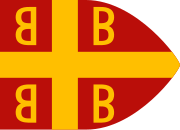
Back Exèrcit bizantí Catalan Ο Στρατός της εποχής των Παλαιολόγων Greek Ejército Paleólogo Spanish Exército paleólogo Portuguese Византијска војска (Палеолози) Serbian
| Byzantine army of the Palaiologan period | |
|---|---|
 Imperial flag (basilikon phlamoulon) | |
| Leaders | Byzantine Emperor |
| Dates of operation | 1261–1453 |
| Headquarters | Constantinople |
| Active regions | Bithynia, western Anatolia, Thrace, Morea, Macedonia, Epirus, Crimea. |
| Size | 20,000 troops (1279).[1] |
| Part of | Byzantine Empire |
| Allies | Golden Horde, Ilkhanate, Umur Beg, Catalan Company, Genoa |
| Opponents | Ottoman Sultanate, Serbian Empire, Bulgaria, Sultanate of Rum, Achaea, Duchy of Athens, Kingdom of Sicily, Empire of Trebizond, Despotate of Epiros, Catalan Company. |
| Battles and wars | Bapheus, Nicaea, Pelekanon, Nicomedia, Gallipoli, Adrianople, Philadelphia, Constantinople, Thessalonika, Constantinople |
The Palaiologan army refers to the military forces of the Byzantine Empire under the rule of the Palaiologos dynasty, from the late 13th century to its final collapse in the mid-15th century. The army was a direct continuation of the forces of the Empire of Nicaea, which itself was a fractured component of the formidable Komnenian army of the 12th century. Under the first Palaiologan emperor, Michael VIII, the army's role took an increasingly offensive role whilst the naval forces of the empire, weakened since the days of Andronikos I Komnenos, were boosted to include thousands of skilled sailors and some 80 ships. Due to the lack of land to support the army, the empire required the use of large numbers of mercenaries.
After Andronikos II took to the throne in 1282, the army fell apart and the Byzantines suffered regular defeats at the hands of their eastern opponents, although they would continue to enjoy success against the Latin territories in Greece. By c. 1350 the Empire's inefficient fiscal organization and incompetent central government made raising troops and the supplies to maintain them a near-impossible task, and the Empire came to rely upon troops provided by Serbs, Bulgarians, Venetians, Latins, Genoese and Turks to fight the civil wars that lasted for the greater part of the 14th century, with the latter foe being the most successful in establishing a foothold in Thrace. By the time the civil war had ended, the Turks had cut off Constantinople, the capital of the Byzantine Empire, from the surrounding land and in 1453 the last decisive battle was fought by the Palaiologan army when the capital was stormed and sacked, falling on 29 May.
- ^ G. Ostrogorsky, History of the Byzantine State, 483
© MMXXIII Rich X Search. We shall prevail. All rights reserved. Rich X Search